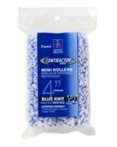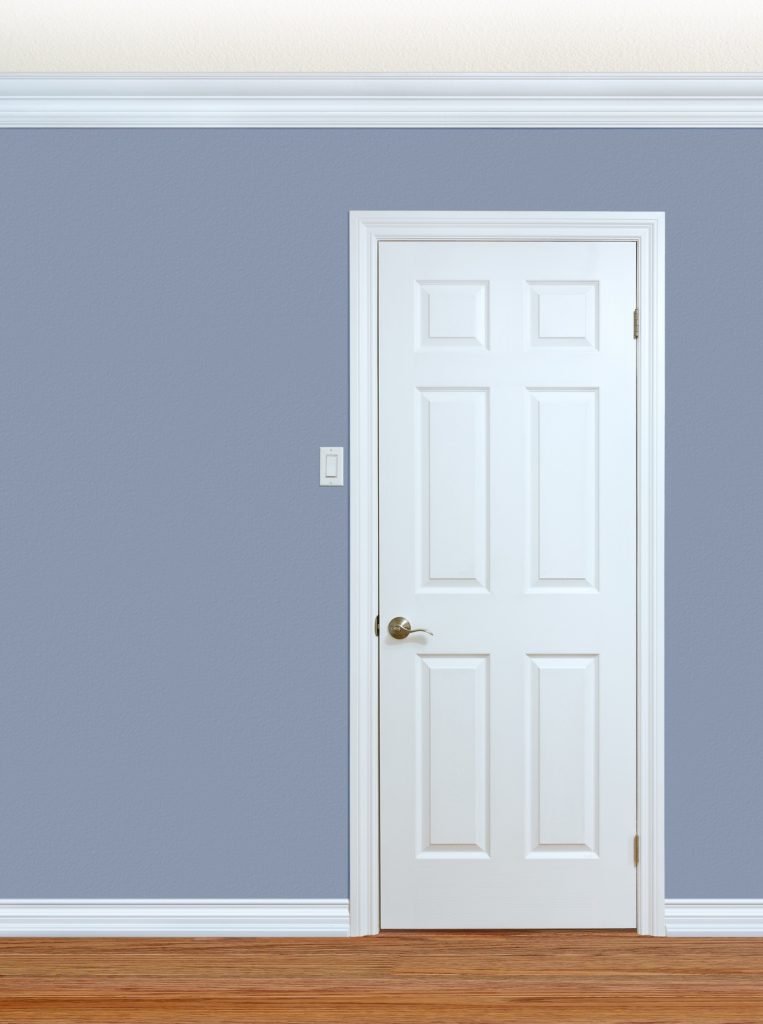Do You Paint Door With Brush or Roller?
Painting a door with a brush or roller is the primary topic. Several other questions and topics arise when determining painting a door like, best door finish, a door is primed, painting front door, gloss paint without marks, paint interior doors, how to paint paneled doors, also how to gloss paint a door using a roller.
Giving you examples of several different circumstances, hopefully you will land on the topic that best fits your request of information seeking.
A brush and roller serves two different paint applications, both very important for a clean, smooth finish that most museums would appreciate. Speaking of museums, have you ever touched the edge of a door or molding, only to feel a rough, sandpaper feel? If you have, I bet it would not be in a museum, certainly not using the correct brush or roller.
Just about every door needed painted will need your expertise sanding first. Doors that come out of the factory are most commonly primed, but not sanded smooth on edges, especially where the hands normally touch the doors besides the door handles themselves.
If not sanded first, these edges will fill rough as sandpaper, which should have been used before picking up a brush or roller, having the very best finish.
OK, getting back on the subject of painting doors, wondering which best brush or roller to use, it depends on the construction of your door; How it is made, as we will get into this further down the page. I will tell you either slab or panel, interior or front door just to give you a teaser to keep reading.
What is The Best Paint Finish For Interior Doors?
Interior Door Paint Finishes
All interior doors listed below are prime candidates for semi-gloss, gloss, or high-gloss finishes
- Interior Slab Doors
- Interior Raised Paneled Doors
- Solid Wood Interior Doors
- Hollow-core Interior Doors
Semi-gloss paint finish is widely used on all interior trim, which includes door jambs, and doors themselves. This finish gives the liberty of rigorous cleaning with a damp cloth, continual dusting. These large surfaces tend to collect dust, similar to furniture within the interior, which requires regular cleaning, and semi-gloss or high-gloss paint finish is best.
If you are wondering what is the best finish for your doors, I have to ask a question with a question. I know that is impolite, but given the question, an answer to any question is "What would a monkey do" -or- "What would a monkey want"?
I believe a monkey would want a smooth car like finish. The best paint sheen that will provide a glossy smooth paint finish is semi-gloss or high gloss. Anything else you'd better stay away from, or you might find your bananas gone the next day.
Best Roller For Painting Doors
No need to get anything fancy, choosing the best roller painting doors. The very best roller is one which is easy to handle, use, and clean. Calling these a Winnie-roller
We normally use this set up with either a 3/8"-1/2" Blue Knit Roller Skin, depending on which product and door surface we are painting.
What Does It Mean A Door Is Primed?
Wondering what it means a door is primed? Generally, most new door units come from the factory primed. The door casing, molding and door itself all primed and sealed. However, just because the door unit is primed, does not mean it's ready for finish coat of paint. Most surfaces need a light sanding to take place, wiping off all dust this is caused, before any paint is applied.
Believe you me, if you paint a primed door before sanding, trying to sand afterwards, will be much more difficult. Sanding a primed door, concentrate on top, sides, casing, and door jambs. These are areas hands are most likely to touch, feeling that smooth painted surface.
How Do You Paint A Front Door?
One of the most important doors to know how to properly paint is the front door. The front door is your welcome mat to everyone entering your home, and first impression what to expect inside. Ideally if you are brushing and rolling a front door, you'll want that same car finish as you would get spraying.
Having very little if any marks on your front door, after all the paint has dried. Depending on how quick your paint dries, how efficiently paint is applied, you may want to add a paint conditioner to the front door paint, giving you assistance, laying this on as professionally possible, having that smooth car-like museum finish.
 Floetrol Paint Conditioner
Floetrol Paint Conditioner
- Fortifies interior acrylic/latex-based paints
- Produces beautiful results, even on trim and doors
- Formulated to eliminate brush marks
- Makes painting easier
- 6-month limited warranty against product defects
If you are still not happy with painting results, do not get in a hurry. Let the paint dry and cure, normally a week. Then you can lightly sand blemishes, touching up troubled areas. If you added Floetrol to your paint to begin with, strongly recommend using that same exact left over product when touching up, reducing the possibility of flashing.
This opens up another topic painting front doors. If you originally sprayed it, don't try brushing and rolling for touch-ups. You'll need to re-spray it for greatest results.
How To Paint A Door With A Roller?
How to paint a door with a roller is a very common question, we are asked several times a year. For the record, you'll want to dip the Winnie-roller in the paint, shaking off using a couple quick turns in the bucket, then laying it on the door, horizontally or vertically. Making a big W mark will leave a good amount to work with, continuing to paint even.
Another tip is never flip roller frame left to right while rolling out coat, as the frame pressure is different from framework to end. This will ensure you don't leave any heavy lines, and lighter ones. Laying paint with a roller is an art, requiring a bit of finesse with every stroke.
Once door is coated uniformly, leave it alone to dry. Do not keep applying additional coats until the previous one has properly dried. If you do, you'll have one big mess on your hands.
How To Gloss Paint A Door Without Brush Marks?
Determining how to gloss paint a door without brush marks, knowing what temperature you are applying, how quickly the paint is drying are two important factors, not leaving brush marks. If added gloss is needed, a good product to use is Golden Soft Gel Gloss. This medium will enhance the durability and hardening. Same goes for painting trim without brush marks, lines, or strokes. This can also be used in conjunction with Floetrol.
If temperature is too low, paint not drying quick enough, you may find paint sagging, causing runs or drips. In this case you'll want to bring the front door inside where it's warmer. This is common painting metal front doors during the Winter months in Colorado.
How To Paint An Interior Door?
Knowing how to paint an interior door will help in so many ways, others will love it without you even knowing. First, cleaning any/all dust and foreign matter before painting is best. This way you will not be trapping it under the paint, and making the finish rough to the touch after paint has dried.
Cover any flooring if painting doors inside. This way, making cleanup afterwards a breeze. Mask door hardware, using a sharp razor knife cutting tape to exact measurements. Don't worry about paint on glass. You can paint a very good coat of paint on a 10 panel glass door, getting every edge and corner painted properly. Coming back with a flat razor, cutting the dried paint cleanly off the glass. This can be done using an Alkyd Oil, or a Acrylic Latex form of paint. However, most interior enamels today are water-borne latex formulations.
Removing masking while the paint is still wet allows you not having to cut tape edges. If you do wait for the paint to dry like many, you will need to use that sharp razor knife with fine tip cutting tape, so it does not pull fresh dried paint off with the tape you are discarding.
Having a freshly painted smooth door is an undetected reward to you and others nearby. If the door is not smooth, nor freshly painted, a red flag becomes obvious & apparent for any door in your home. Therefore, take your time, meticulously paint each door, as these surfaces are some of the largest painted trim pieces in your home. Keep a wet edge while painting, and once dried, the gloss finish will shine through.
How To Paint A Panel Door?
Painting a panel door will require using both brush and roller for a finer paint finish. Having painted 1000's of these over the years, knowing what works best, you'll want to pick out your favorite Purdy™ or Wooster™ brush with a fine bristle, and thick shank.
Dipping brush, you'll want to brush evenly all of the indented moldings, of the individual panels, letting dry properly.
After moldings have dried, pick up that 6" Winnie-roller with say a 1/2" nap, rolling out all flat areas on the door surface, letting this dry properly as well. Both separate coatings bond as one, leaving a paneled door freshly painted professionally, as a spray finish.
How To Gloss Paint A Door With A Roller
Best way to gloss painting a door using a roller, is simply keeping a wet edge at all times. A semi-gloss paint has it's own gloss built into the formulation, and utilizing the maximum amount of it's own gloss is laying it on as quickly and uniformly as possible.
Trick is not to keep brushing and/or rolling, not over doing it. 3-4 brush or roller strokes is normally sufficient. Adding an additional brush stroke if going over a darker color. Which brings up another issue.
If you find yourself needing to brush too much, you might want to consider either using a better quality paint, and/or priming it first with 50% color additive in the primer, before applying the final finish coat.
That way, you'll be utilizing the maximum amount of gloss in the paint, painting doors and it's trim.
That's It! Hope you find this helpful on your next door painting project using a brush and/or roller, and welcome any comments below!













[…] contractors will generally apply back rolling or back priming in a manner that is effective. Knowing how to best paint doors using either a brush or roller. They will also use paints that are of high quality. That is, those that can withstand inclement […]
[…] Do You Paint Door With Brush or Roller? […]
[…] painting equipment assists the ease of laying on paint the most efficient means possible. Correct width of brushes, rollers, masking tape, ladders, paint sprayers, to brown […]
Just answer the question googled. The writer must have short-man’s syndrome. Trying to over prove himself with info not asked.
Glad you found your answer Jane, covering several topics painting front doors.
When painting the front door, outside only do you paint the narrow edge or not; interior color is white and outside is red.
Correct, as the door jamb is probably painted white, also. So painting outside door it’s accent color.